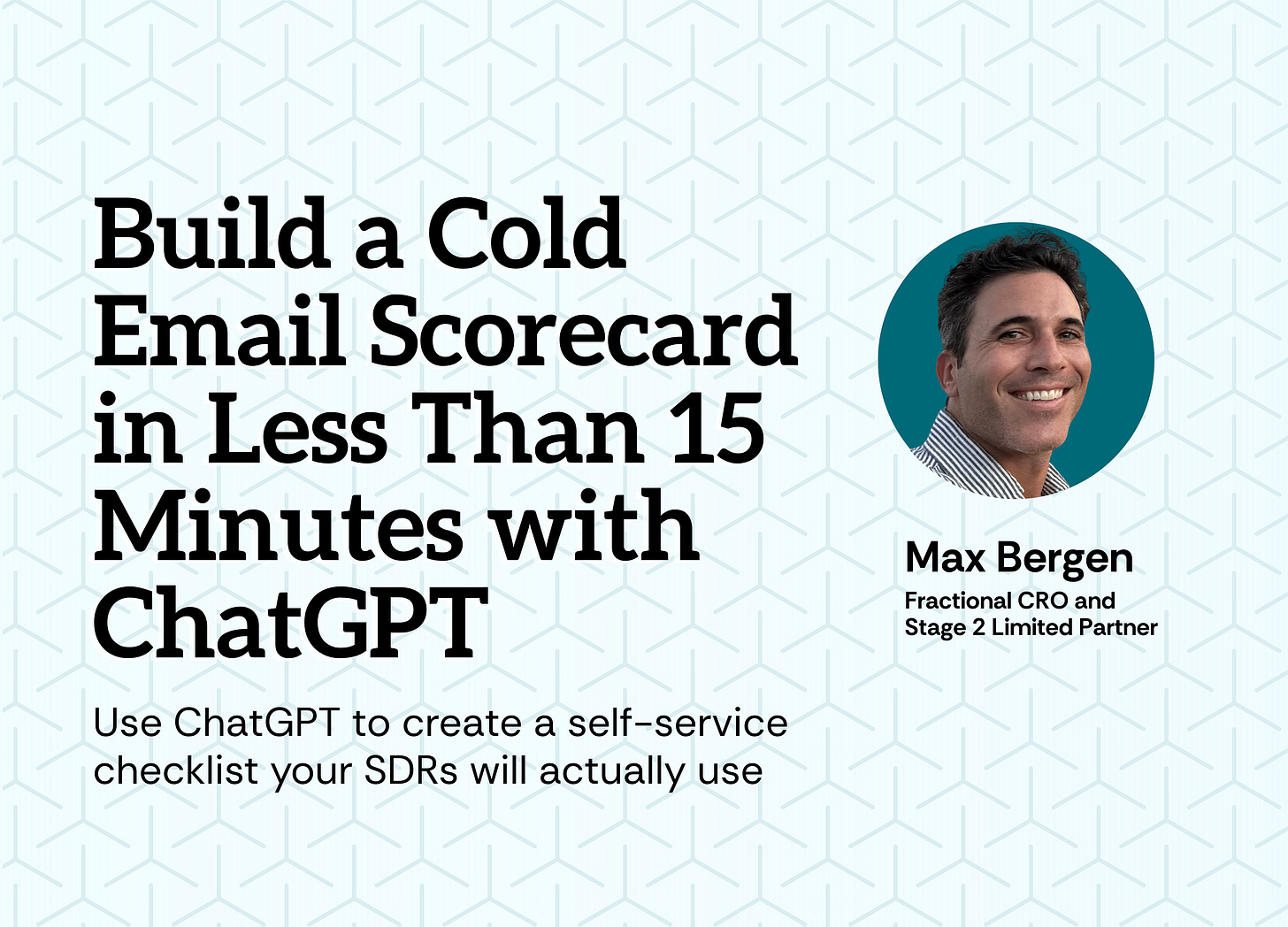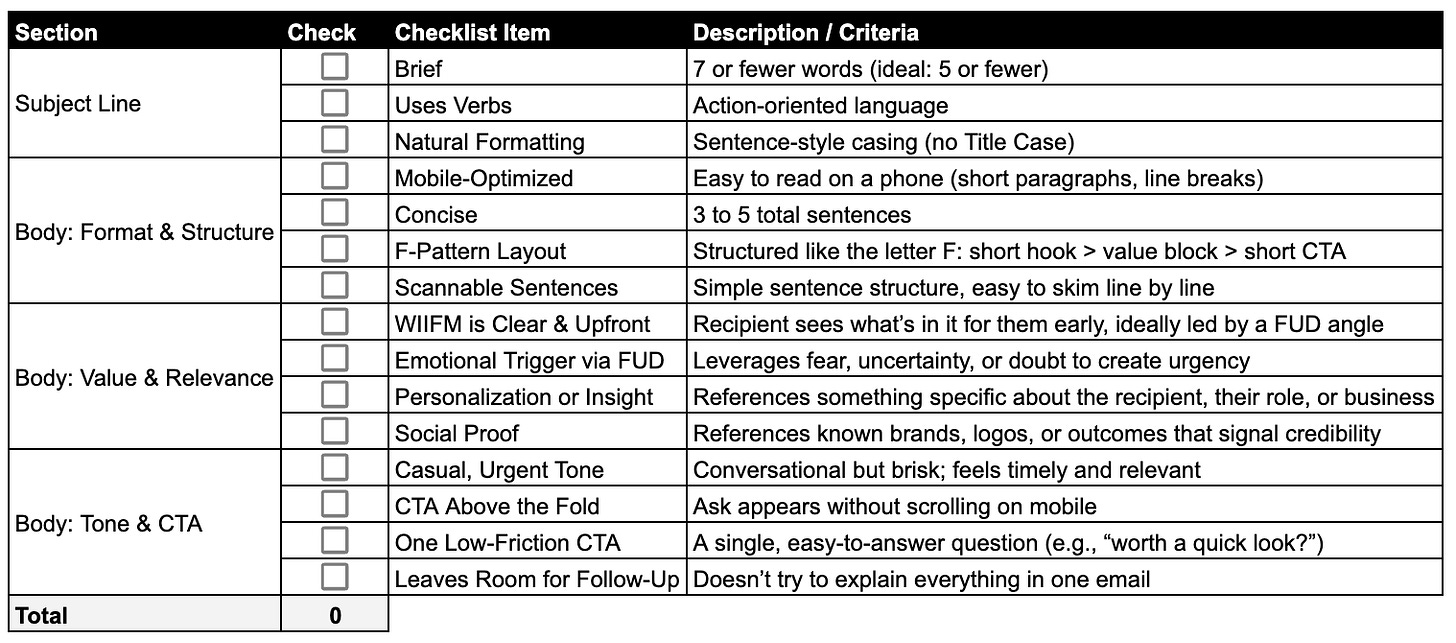Build a Cold Email Scorecard in Less Than 15 Minutes with ChatGPT
Use ChatGPT to create a self-service checklist your SDRs will actually use
DEAR STAGE 2: I’m a BDR manager with a team of 8 focused on outbound prospecting. We have varying degrees of experience on the team and limited budget for new tools. I don’t have the bandwidth to go as deep as I would like coaching each member of the team on optimizing their email outreach. Any ideas on how we can uplevel email quality? ~EMAIL OPTIMIZER
DEAR EMAIL OPTIMIZER: This week’s advice comes from Max Bergen. Max has led sales at multiple startups, consulted with and advised many more, and is a talented GTM systems builder. When I asked Max for his take on this question, he brought back a system that you can literally put into action today.
The concept is simple: empower SDRs to self-assess their emails before they hit send. You’ll spend less time editing, they’ll develop better instincts, and reply rates will go up. The best part? You can build a customized version for your team in less than 15 minutes using ChatGPT.
Read on for Max’s advice, including two prompts to get you started!
The Components of an Effective Prompt
When you ask ChatGPT to create something as specific as a scorecard, you can’t just say “make me a checklist.” You need to provide structure and context. Here are the most important components to include:
Objective: Clearly state the mission (e.g., create a cold email scorecard for SDRs)
Persona: Tell ChatGPT who to act as (e.g., a SaaS Sales Manager and cold email expert)
Context: Add details about your ICP, industry, and product category so the output is relevant
Instructions: Give step-by-step guidance (e.g., 4 categories, 3–4 criteria each, good vs. bad examples)
Constraints: Limit length, require plain language, and keep it practical
Tone: Specify the voice (conversational, coaching, SDR-friendly)
Response Format: Say how you want it delivered (Markdown, checklist boxes, recap at the end)
This is the difference between an average prompt and one that generates a ready-to-use, show-off-worthy output.
Example Prompt You Can Steal: #1
Here’s a concise prompt that includes all of the components of an effective prompt:
Create an SDR-friendly cold email quality scorecard that helps reps self-assess their outbound emails before sending. The goal is to improve open and reply rates by focusing on subject line quality, structure, value, personalization, tone, and CTA clarity. Act as a SaaS Sales Manager and cold email expert who trains SDRs at early-stage startups.
The scorecard should reflect the ICP (e.g., CIOs at Fortune 500s, CFOs at mid-market manufacturers, or HR leaders at high-growth startups). These prospects are busy, skeptical, and receive high volumes of cold outreach, so adapt tone and examples to fit their role, industry, and the product category (cybersecurity SaaS, HR tech, workflow automation, etc.).
Organize the scorecard into four categories—Subject Line, Format & Structure, Value & Relevance, and Tone & CTA—with 3–4 clear, scannable criteria each. Provide a short descriptor and a good vs bad example for every criterion (e.g., good subject line: “Cut payroll errors in half” vs. bad: “Optimize Enterprise HR Automation Platforms Today”).
Add a scoring system (11–15 = strong, 8–10 = needs tweaks, <8 = rewrite) and format in Markdown with checklist boxes. Keep the tone conversational and practical so SDRs can use it in under two minutes. End with a recap of the four sections, scoring rules, and a reminder to keep emails concise, personalized, and follow-up friendly. The scorecard should be a framework, not a template, and should avoid any confidential data.
This is just a sample prompt, so feel free to tweak the components as you see fit to get the desired output.
Example Prompt You Can Steal: #2
Here is a more detailed prompt that includes all of the components of an effective prompt:
Objective (Mission)
You are to create a detailed, SDR-friendly cold email quality scorecard (“Sick Email Scorecard”) that helps Sales Development Representatives (SDRs) self-assess their outbound cold emails before sending. The goal is to ensure emails achieve high open and reply rates by focusing on subject line quality, structure, value delivery, personalization, tone, and CTA clarity.
Persona (Role)
Act as a senior SaaS Sales Manager and email copywriting expert who has trained SDRs at early-stage startups. You specialize in creating frameworks that are easy for SDRs to apply quickly and consistently while still improving outcomes.
Context
The scorecard will be used by SDRs who prospect into [insert your target ICP — e.g., CIOs at Fortune 500 companies / CFOs at mid-market manufacturing firms / HR leaders at fast-growing tech startups]. These prospects are busy, skeptical of vendor outreach, and accustomed to receiving high volumes of cold emails. The scorecard must account for industry tone (casual vs. formal), decision-maker role, and value props unique to [insert your product category, e.g., cybersecurity SaaS, HR tech, workflow automation].
Instructions
Create a structured scorecard with 4 main categories:
Subject Line
Format & Structure
Value & Relevance
Tone & CTA
Each category should contain 3–4 clear, simple criteria that SDRs can check off.
For each criterion, provide:
A short descriptor (e.g., “Brief – 7 words or fewer”)
A simple example of good vs bad execution (in SDR-friendly language)
Include a scoring system (e.g., 11–15 = Strong, 8–10 = Needs Tweaks, <8 = Rewrite)
Ensure the checklist is:
Mobile-first - SDRs should be able to use it in <2 minutes
Clear & scannable - No jargon
Follow-up friendly - Leaves flexibility for future outreach
Format the output in Markdown for easy copy/paste into docs or Notion
Constraints
Keep total length under 500 words
Use plain, SDR-friendly language
Do not over-engineer or include unnecessary theory. The scorecard must be practical and actionable
Examples must stay relevant to the ICP and industry context provided
Tone
Conversational, supportive, and practical, like a Sales Manager coaching their team in real time. Avoid academic or overly formal language.
Response Format
Use Markdown headers and sub-bullets
Clearly separate sections with dividers (---)
Provide checklist boxes [ ] for SDRs to tick.
End with scoring guidelines and a “pro tip.”
Samples
Good subject line: “Cut payroll errors in half”
Bad subject line: “Optimize Enterprise HR Automation Platforms Today”
Good CTA: “Worth a quick look?”
Bad CTA: “Please schedule a 30-minute demo here: [link]”
Reasoning Steps
Explain why each section matters for SDRs (e.g., “WIIFM upfront ensures the reader knows what’s in it for them immediately”). Keep explanations short, 1 sentence max, to avoid slowing SDRs down.
Recap
At the end of the output, restate:
The 4 sections (Subject Line, Format & Structure, Value & Relevance, Tone & CTA)
The scoring guidelines
Reminder to keep emails concise, personalized, and follow-up friendly
Safeguards
Do not create a “universal” email template. Instead, focus on the framework
Ensure examples never reveal confidential company data or real customer names
Sample Scorecard
You can then turn the output into an exportable table and drop it into your system of choice - google sheets, Notion, etc…
Scoring Guidelines
11–15 checks = 🔥 Strong, high-performing email
8–10 checks = ✅ Good but room to optimize
<8 checks = 🚨 Needs revision to drive opens and replies
Hope this gives you some ideas to get started with your own checklist!
Until next week!





Great concept. I created a quick Cold Email Scorecard app using the principles of this article:
https://cold-email-scorecard-8o6j.bolt.host